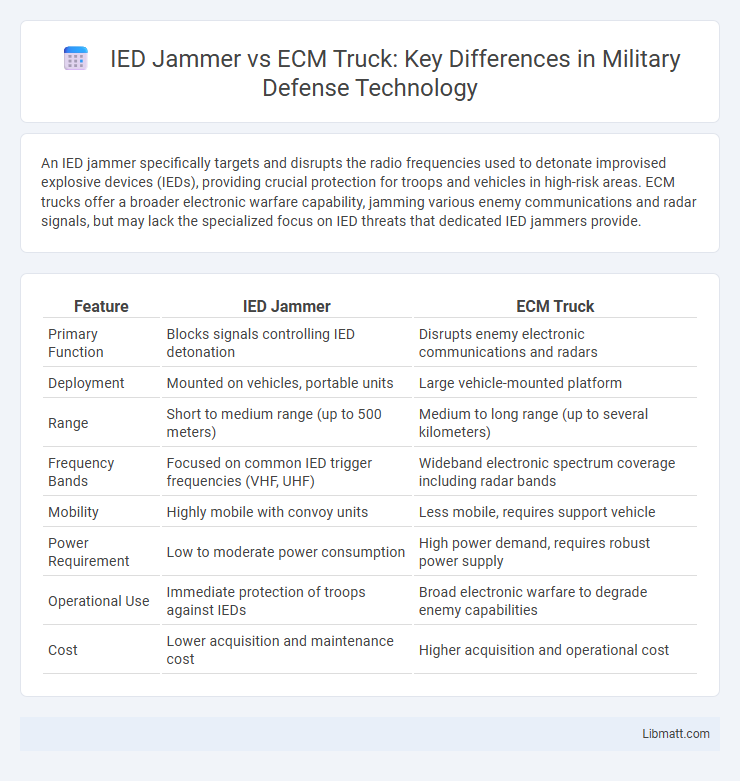An IED jammer specifically targets and disrupts the radio frequencies used to detonate improvised explosive devices (IEDs), providing crucial protection for troops and vehicles in high-risk areas. ECM trucks offer a broader electronic warfare capability, jamming various enemy communications and radar signals, but may lack the specialized focus on IED threats that dedicated IED jammers provide.
Table of Comparison
| Feature | IED Jammer | ECM Truck |
|---|---|---|
| Primary Function | Blocks signals controlling IED detonation | Disrupts enemy electronic communications and radars |
| Deployment | Mounted on vehicles, portable units | Large vehicle-mounted platform |
| Range | Short to medium range (up to 500 meters) | Medium to long range (up to several kilometers) |
| Frequency Bands | Focused on common IED trigger frequencies (VHF, UHF) | Wideband electronic spectrum coverage including radar bands |
| Mobility | Highly mobile with convoy units | Less mobile, requires support vehicle |
| Power Requirement | Low to moderate power consumption | High power demand, requires robust power supply |
| Operational Use | Immediate protection of troops against IEDs | Broad electronic warfare to degrade enemy capabilities |
| Cost | Lower acquisition and maintenance cost | Higher acquisition and operational cost |
Introduction to IED Jammers and ECM Trucks
IED jammers emit radio frequency signals to disrupt the remote detonation of improvised explosive devices by blocking or confusing enemy communications. ECM trucks integrate advanced electronic countermeasures, including powerful jamming systems, radar detection, and signal intelligence to prevent IED activation and enhance battlefield situational awareness. Both technologies play critical roles in force protection by neutralizing threats from remote-controlled explosive devices through electronic interference and detection.
Core Functions: IED Jamming vs Electronic Countermeasures
IED jammers primarily focus on disrupting radio frequencies used to detonate improvised explosive devices by emitting targeted signals that block enemy transmissions, protecting personnel and vehicles from explosions. Electronic Countermeasures (ECM) trucks provide a broader spectrum of defense by employing advanced signal detection, classification, and multi-frequency jamming techniques to neutralize various electronic threats, including IED triggers, enemy radar, and communication systems. Both systems enhance battlefield survivability, but ECM trucks offer comprehensive electronic warfare capabilities beyond the singular objective of IED jamming.
Technology Comparison: Jammers vs ECM Systems
IED jammers emit targeted radio frequency signals to disrupt the communication between remote detonation devices and explosive devices, effectively neutralizing threats by blocking the triggering signals. ECM trucks integrate advanced electronic warfare technology, combining multiple signal detection, analysis, and jamming capabilities in a mobile platform to counter a broader spectrum of threats beyond just IED triggering frequencies. While jammers focus primarily on signal disruption within narrow frequency bands, ECM systems offer adaptive, multi-layered electronic countermeasures capable of real-time threat identification and neutralization, making them more versatile in complex combat environments.
Deployment Scenarios: When to Use Each
IED jammers are primarily deployed in urban or convoy operations to prevent remote detonation of improvised explosive devices by disrupting radio signals within targeted frequency ranges. ECM trucks, equipped with more powerful and versatile electronic countermeasure systems, are best suited for large-scale military operations or high-threat environments requiring extensive signal jamming over broader areas. Selecting between an IED jammer and an ECM truck depends on mission scale, operational terrain, and the specific electronic threats anticipated.
Effectiveness in Countering IED Threats
IED jammers use radio frequency signals to disrupt remote detonation of improvised explosive devices, providing a mobile defense against triggering mechanisms. ECM trucks integrate multiple electronic countermeasures, offering broader spectrum disruption and enhanced detection capabilities to neutralize diverse IED threats. Your choice depends on operational requirements, with ECM trucks generally delivering higher effectiveness in complex environments due to their advanced, multi-faceted approach.
Mobility and Coverage: On-Foot Units vs Vehicle Platforms
IED jammer systems vary significantly in mobility and coverage depending on deployment platforms. On-foot units offer enhanced maneuverability and can operate discreetly in tight urban environments but typically cover a smaller radius, suitable for close protection scenarios. ECM trucks provide extensive coverage with powerful jamming signals capable of neutralizing threats over broader areas, making them ideal for convoy protection and large-scale operations where mobility is restricted to roads.
Power and Range Capabilities
IED jammers typically operate with limited power output designed for short-range disruption of explosive devices, focusing on localized protection. In contrast, ECM trucks are equipped with high-power transmitters and advanced antenna arrays, providing broader coverage and enhanced signal penetration to counter a wider spectrum of threats. Your selection between these systems depends on the required operational range and the power needed to effectively neutralize electronic threats in varying environments.
Crew Training and Operational Complexity
IED jammers require specialized crew training to effectively identify and neutralize improvised explosive devices using electronic countermeasures, emphasizing precision in signal disruption. ECM trucks involve more complex operational protocols, demanding extensive technical expertise to manage multiple electronic warfare systems and coordinate with ground units during missions. Both systems necessitate rigorous training, but ECM truck crews face higher complexity due to integrated technology and multifunctional roles in electronic warfare.
Cost and Maintenance Considerations
IED jammers typically have lower upfront costs and simpler maintenance requirements compared to ECM trucks, which are more complex and expensive due to their advanced electronic countermeasure systems. Maintenance for ECM trucks involves specialized technicians and frequent updates to software and hardware components, increasing long-term operational expenses. Cost-effectiveness of IED jammers suits smaller missions, while ECM trucks are preferred for sustained operations demanding robust counter-IED capabilities despite higher maintenance investments.
Future Trends in Anti-IED Electronic Warfare
Future trends in anti-IED electronic warfare emphasize enhanced integration between IED jammers and ECM trucks, leveraging AI-driven signal detection and adaptive frequency hopping to counter evolving threats. ECM trucks are expected to incorporate advanced cognitive radio technologies, enabling real-time analysis and automatic adjustment against sophisticated Improvised Explosive Device signals. Your security operations benefit from increased network-centric coordination, allowing seamless communication between jammers and command centers to neutralize threats more effectively.
IED jammer vs ECM truck Infographic

 libmatt.com
libmatt.com